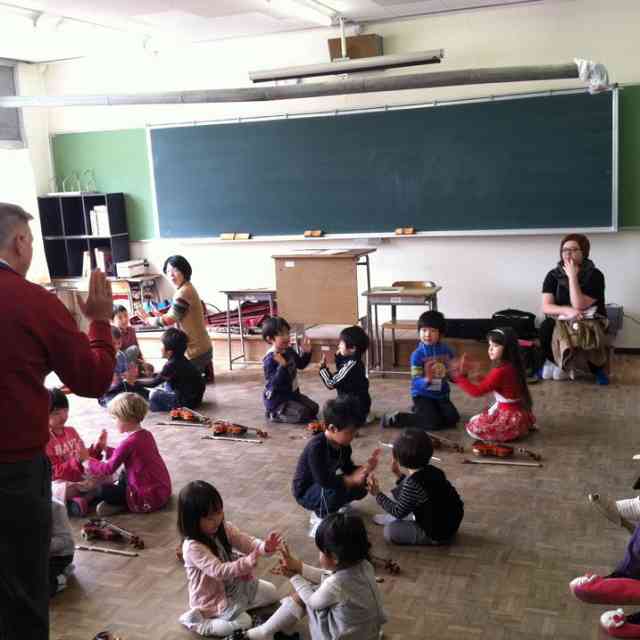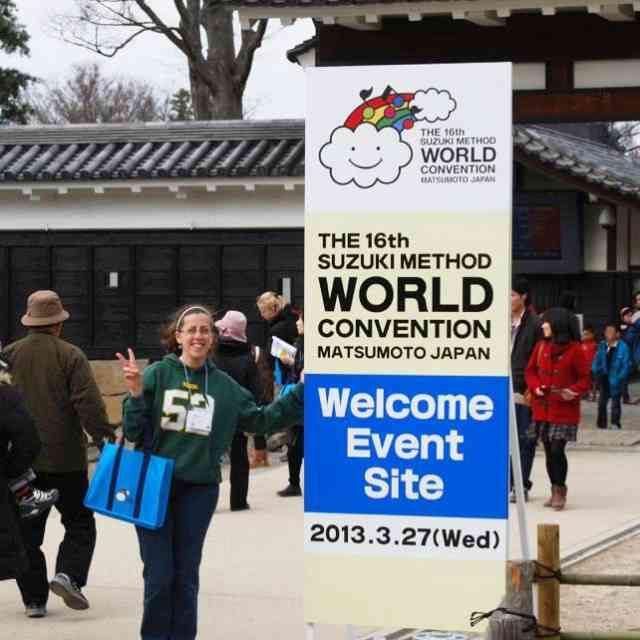See Ed’s previous update from the Convention, and more from Matusumoto.
March 28—Thursday
The 16th Suzuki Method World Convention officially opened with a gathering for all participants in the Matsumoto City General Gymnasium. The ceremony began with an orchestra rendition of Dr. Suzuki’s “Wishing—A prayer for the happiness of all children” performed by the international guest orchestra conducted by Koji Toyoda. I wish that I could express to you the beauty of the string and flute tone that came from this group. It was truly inspiring.
Of the many greetings and addresses which were presented by the Mayor of Matsumoto, the Governor of the Nagano Prefector and several other dignitaries, it was the speech by Her Imperial Highness the Princess Hisako Takamado that was the most extraordinary. Both her late husband and all three of her children were Suzuki students and she spoke so eloquently about the method which was very real and heartfelt. Her understanding of and ability to articulate the Suzuki philosophy was astounding and everyone at the conference enjoyed hearing her speak.
We also were treated to a performance of Haru no Umi by Michio Miayagi. This was played by a group of about 20 Koto players from the Seihi Hogakukai group and several of the advanced violin students.

Japanese students of Akira Kubota and Naoki Hirooka performing the first movement of the Hayden Concerto in C major.
The opening ceremony ended with all the students performing together a few pieces from the Suzuki Repertoire.
After lunch, we had two symposium sessions. The first, titled “To Copy and Learn—Physics and the Suzuki Method,” was presented by Professor Ryugo Hayano, a professor of Physics at the Univesrity of Tokyo who was also was a violin student of Dr. Suzuki and participated in the First Suzuki Ten Children Concert Tour to America.
Our second symposium was titled “Remembering Dr. Suzuki.” It was presented in three parts. The first, a performance of Mozart’s “The Hunt” string quartet was played by Kenji Lobayashi, Kiichiro Momine, William Precuil, and Mineo Hayashi. The violinists and cellists had all studied with Dr. Suzuki during their childhood and then went on to have professional careers.
The middle section of the symposium was a panel discussion which covered the early years of Dr. Suzuki’s teaching before he moved to Matsumoto, the period when the method developed in Matsumoto, and finally, the expansion of the method beyond Japan to the rest of the world. The panel was comprised of Koji Toyoda, Kenji Kobayshi, Hiroko Suzuki and William Starr
This session was one that I was really looking forward to, but in the end it was very unsatisfying. I’m sure that there were some wonderful stories begin shared between the Japanese members of the panel, but the translation was very sparse, and I felt that we did not get to hear all of the information. Well, this is very interesting to be participating in a conference where the primary language is not your own. I would say that this particular session was the exception rather than the norm. Most of the translations seem entirely adequate and there is also an option available to pay for earphones to have simultaneous translations for most sessions. Next time, I think I will try that option.
March 29—Friday
Today, the conference class schedule began for the students who were attending the conference. The typical day looked something like this. In the morning, a two-and-a-half hour group class arranged by instrument and level. Some instrument groups may have had a wider range of participants, but in the violin area, children were grouped by pieces and in some cases there were two or more groups devoted to a certain piece with approximately 30 children in each class. This class was followed by lunch. After the break, all instruments gathered together by instrument for a special group class. As I was assigned to help tune the violins, I can only report on what was happening in the gymnasium. My guess is that there were upwards of 2000 violins ranging from Twinkle to Mendelssohn Concerto. All played together and really seemed to enjoy the group class leaders. Two of my favorites to watch were Nicholas Kendall from the US and Christophe Bossuat from France.
The morning class that I have been assigned to teach is a Twinkle Variation class with about 30 Japanese children and four or five from other countries. The age range is from three to eight with the majority of the children appearing to be about four or five. When I first saw that this class would last for two-plus hours, I was certain that there must be a mistake on my schedule. In fact, the class works quite well. I team teach the class with two of the Japanese Suzuki teachers, Noriko Kaneko and Motoko Nakamura. After we have tuned and lined up the children, Noriko does some technical work on the bow hold and tone production. The emphasis is on getting the bow “into” the string and using a good bow speed. It is interesting to me that “playing together” or ensemble skills are not a priority at all. Motoko and I assist by helping the children to maintain their bow holds and adjusting their instruments so that they stay in tune.
After about 45 minutes, the children take a break, and I work them for another 50 minutes or so. As Noriko has done all the hard work, I am able to really just have some fun and enjoy playing some of the games that I have learned from some the great teachers like Bill Star and John Kendall… and Suzuki himself. The activities that I have planned for the class are very warmly received by both the children and the parents. Talking is at a minimum, so nonverbal teaching skills are a real necessity! Thank goodness, I have remembered Dr. Suzuki ending every group class with a little piece of chocolate for everyone who demonstrates good violin posture while playing the twinkles… and we end each day’s session with a chocolate Easter egg balanced on the body of the violin.
The concerts at the Suzuki world conventions can among the most inspiring sessions. It is wonderful to have the opportunity to hear the results of the Suzuki Method’s spread across the globe, and also the see how it continues to flourish on such a high level here in Japan. There are many concerts scheduled throughout the conference, sometimes simultaneously, and many were sold out within days of the tickets going on sale on the web site.
Yesterday, I was able to attend an afternoon concert which was comprised of nine groups of children from various regions of Japan, England, United States, and Australia. There was a wide variety of ages, levels and genres of music presented, but all performed at a very high technical and musical level. Two favorites were the Alegre Strings from the Merit School of Music in Chicago under the direction of Michele George, and the group of about 100 violins from the Japan Summer school that performed Michael McLeans’s arrangement of the Khachaturian Sabre Dance and was led by Brian Lewis.
In the evening, I had the privilege of dining with several of my own mentors and friends. Paul Landefeld, Joan and Sandy Reuning, Gilda Barston, Teri Einfeldt, Pam Brasch, Christy Felsing and I enjoyed a delightful Japanese dinner including shabu-shabu and tempura along with several menu items that were delicious but not necessarily identifiable.








Comments